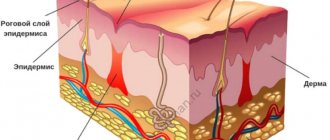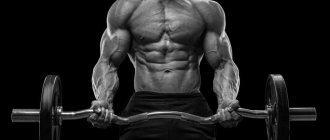Overtraining[edit | edit code]
Decrease in performance due to overtraining
Athletes talk about overtraining.
Overtraining
- a physical, behavioral and emotional state that occurs when the volume and intensity of the training program exceeds recovery capacity. Overtraining causes progress to stop; moreover, a decrease in strength and mass is possible. Overtraining is one of the most common problems in bodybuilding, but it can affect sprinters and other athletes as well.
Causes of overtraining[edit | edit code]
Overtraining often occurs among beginners who subject an unprepared body to serious loads, as well as among professionals whose progress decreases and they seek to correct the situation by increasing the load. The main reason is the excessive pursuit of your sports goals. Many people tend to believe that the harder they push themselves in their workouts, the greater their results will be, but this is completely misleading. Bodybuilding and fitness require a special approach, which must be harmoniously combined with human physiology. Like medicine, sport can treat and cause disorders, the only question is the dose.
Recently, information has emerged that overtraining may be a consequence of sports addiction. According to this theory, during training and immediately after it, special substances are secreted into the blood - endorphins, which cause a feeling of euphoria and joy. Some people note a particularly positive state after training, and in the absence of the latter, a state similar to drug withdrawal is observed: a drop in mood, an obsessive desire to go to the gym, and so on. A person tries to visit the gym more often, and eventually overtraining occurs. [1]
In the work of S. Petibois[2], carbohydrate metabolism disorders are even considered as one of the actual causative factors in the occurrence of a state of overtraining in athletes in sports aimed at the primary development of endurance.
Physiology of overtraining[edit | edit code]
Biochemical indicators of overtraining during endurance training
An increase in results in strength and physical condition occurs during the recovery period after training (see Supercompensation). This process takes from 24 hours to several days. According to some data, complete restoration of muscle tissue after high-intensity training requires up to 1 month. If there is an imbalance between the volume of training and recovery time, then the athlete enters a state of training plateau, and then a decrease in all sports performance occurs. A mild degree of overtraining requires several days of rest or a decrease in training activity until the athlete’s physical condition is fully restored. If a more severe degree is allowed to develop, the symptoms will steadily progress and the athlete’s condition will worsen; recovery may take several weeks or even months.
The following factors contribute to the occurrence of overtraining: disruption of the body’s circadian rhythm, illness, fatigue at work, menstruation, poor nutrition, etc. Overtraining develops especially often in bodybuilders, whose specific training is high loads, especially during cutting cycles.
Mechanisms of overtraining:
- Micro-trauma to muscles prevails over the speed of their recovery
- Amino acid deficiency. This condition is also called "protein deficiency."
- During fasting, nutritional deficiency leads to the activation of catabolic reactions, during which muscle breakdown occurs.
- With insufficient recovery, stress and illness, cortisol levels increase, which destroys muscles.
- Overload and exhaustion of the central nervous system during training.
Procedures to prevent overtraining
In order for the body to adequately perceive the stress imposed by strength training, the training process will have to be optimized. It's about warming up and cooling down. Warm-up will prepare all body systems for full-fledged work. It is important to gradually “get involved” in the work, and not immediately start with heavy weights. This way you will not overstimulate your psyche and minimize the risk of injury.
The warm-up complex includes: light cardio exercise, joint exercises, static and dynamic stretching, strength exercises with light weights.
Cooling down is the first step towards recovery. Take 5-10 minutes to rest at the end of your workout: it’s extremely useful to just lie down on a fitness mat and relax. Feel how your pulse returns to normal, your muscles become less stiff, and your consciousness becomes clearer.
Powerful means of restoring muscle tissue and increasing the overall tone of the body:
- bathhouse, sauna and hammam;
- hardening;
- taking adaptogens (extracts of Leuzea, Eleutherococcus, Schisandra, ginseng, Rhodiola, etc.);
- sexual activity.
Symptoms (signs) of overtraining[edit | edit code]
Every athlete should be aware of the following signs of overtraining:
- Lack of training progress or regression
- Prostration
- Fast fatiguability
- Depression
- Loss of motivation
- Irritability
- Tachycardia
- Decreased appetite
- Constant muscle pain
- Lymphocytopenia
- Weakened immunity (symptoms of infectious diseases)
- No pumping during training
Remember that often athletes do not experience any of the above signs of overtraining, although they do exist (so-called asymptomatic overtraining), while the athlete is in a state of training plateau, the results do not improve or worsen. If you are experiencing signs of overtraining, you must immediately take immediate action to prevent this condition. You should be skeptical about the listed symptoms, since signs of overtraining can easily be confused with a large number of other pathological conditions, so only a doctor can make an accurate diagnosis.
How to determine overtraining?
The best option is to identify overtraining early, get some rest, and recover before severe symptoms occur.
If you check at least 3 points from the list below, you are most likely beginning to develop overtraining:
- stopping progress in sports results (strength, endurance) or deterioration in performance;
- decreased appetite;
- deterioration in sleep quality, insomnia;
- decreased sexual activity;
- deterioration of physical tone;
- frequent colds;
- regular muscle pain;
- irritability, apathy, loss of attention and concentration;
- deterioration of skin condition.
Definition of overtraining[edit | edit code]
Below are a few strategies to help determine if an athlete is moving into an overtraining state.
Heart rate marker[edit | edit code]
The coach or athlete should monitor morning heart rate daily to determine if the athlete is performing at the appropriate level of effort. It is best to monitor your heart rate in the morning, since the athlete comes to training rested and is not yet affected by the stress of the day. An elevated resting heart rate for two to three days may be a sign of overexertion. In this case, the trainer should reduce the intensity of the training program (if possible, schedule “aerobic compensation” sessions) and closely monitor the heart rate over the next 24-48 hours.
Keeping a training log[edit | edit code]
This simple technique often causes a lot of criticism from athletes. It is usually easy for them to record the load received or the training time, but athletes avoid recording the level of intensity of the load during the training session or the level of fatigue. Athletes train and sacrifice everything to be the best, so admitting that a training session is too intense is not in their nature. Therefore, the coach should closely monitor the athlete and take the time to convey to him the importance of working within his own physical capabilities. The coach may need to keep a specific log that describes the physiological effects of the training on the athlete. The log should record how the athlete feels immediately after the workout, a few hours after it, and the next morning.
Using a heart rate variability monitor[edit | edit code]
Heart rate variability (HRV)
is a physiological phenomenon in which there is a change in the amount of time between heartbeats (also known as cardiac interval). This period of time changes in response to factors such as fatigue, relaxation, emotional states, thoughts and, of course, stress during training. The heart rate quickly responds to these factors to optimally adapt body functions to the environment.
These changes occur independently of the control function of the central nervous system. In fact, these changes are related to the autonomic nervous system and, in particular, to the interaction between the sympathetic and parasympathetic systems. The sympathetic nervous system is an activation system and produces a number of effects such as increased heart rate, increased blood pressure, peripheral vasoconstriction, dilation of the bronchi, dilation of the pupils, increased sweating, release of energy sources into the bloodstream, poor digestion and loss of appetite, that is, it causes fight or flight response. The chemical mediators of these reactions are norepinephrine, adrenaline, corticotropin and some corticosteroids.
In contrast to the above, if the parasympathetic system predominates, the heart rate becomes more regular, blood pressure decreases, breathing slows down and becomes deeper, muscles relax, pupils constrict, appetite and digestion improve. This system operates through the chemical transporter acetylcholine. The dominance of this system represents the body's reaction to peace, relaxation, tranquility, absence of danger and stress.
The state of the human body at a certain moment is determined by the balance between the sympathetic and parasympathetic systems (neurovegetative balance). An important factor is the ability of the human body to change its own balance in favor of one system or another. From a practical point of view, this means that if a high-impact training session is planned for the upcoming day, then after a night's rest it is necessary that the body is in a rested state (predominance of the parasympathetic system). On the other hand, increased sympathetic tone during rest increases oxygen consumption during the production of ATP, which is necessary for recovery, and this is associated with decreased levels of the neurosteroid adehydroepiandrosterone sulfate[3]. In this case, it is recommended to plan a workout with a lower volume of loads.
It has been proven that aerobic compensation sessions accelerate recovery by reducing the tone of the sympathetic system. A few days of hypertonicity of the sympathetic system is a sign of overexertion, which can lead to overtraining if appropriate measures are not taken to reduce the load.
We are very fortunate that it is now possible to use heart rate variability monitors (e.g. BioForce, Omegawave) to assess the body's response to training and prevent overtraining. These devices can be useful in the following cases: to confirm the dynamics of internal load (residual fatigue) planned throughout the microcycle or macrocycle; for better knowledge of the body’s reaction to the training methods used; to help individualize volume, intensity and frequency and therefore optimize each athlete's training program; to help identify and calculate the impact of stressors outside the training environment (eg work, school, family and lifestyle).
What is overtraining
Overtraining is the body's inability to adapt to the load that you set. Most often this happens when you train too often and too intensely, and at the same time do not give your body enough resources to grow. Under such conditions, the muscles simply do not have time to recover. Sooner or later, almost every athlete faces this.
During overtraining, catabolic processes in the body prevail over anabolic ones. The stress hormone cortisol begins to be intensively produced, which stimulates the breakdown of muscle tissue. The body is under serious stress, and in order to overcome it, it needs more recovery resources. First of all, we are talking about sleep and nutrition. If you train in the gym 5-7 times a week, sleep 5 hours and eat 2-3 times a day, then there can be no talk of any recovery or progress, but overtraining will occur very quickly. You'll just burn your muscles.
Overtraining is associated not only with physiological, but also with psychological factors. Regular training, a constant regimen, following proper nutrition... over time, all this turns into hard labor, and the central nervous system begins to react to such a routine accordingly. Add to this everyday problems, nervous tension, accumulated fatigue, constant workload, and you will understand what your psyche experiences during a period of overtraining. In order for sports to continue to be enjoyable and progress to resume, psychological relief is required.
In this article we will look at how overtraining manifests itself in an athlete, what types of overtraining there are and what consequences it leads to.
Treatment of overtraining[edit | edit code]
First of all, the treatment for overtraining consists of physical rest and rest:
- Break from training for a few days
- Reducing training volume
- Sleep (at least 10 hours a day)
- Nutritious food
- Adaptogens and other reducing agents
- Vitamin therapy (especially B vitamins)
- Deep muscle or sports massage
- Cryo- and thermotherapy
Treatment of overtraining is considered complete if the athlete, starting training, begins to progress again.
Recovery from short-term overtraining should begin by stopping training for three to five days. After the specified rest period, the athlete must resume training, alternating each training session with a day off. If the athlete is severely overtrained and requires a longer period of time to recover, for each week of missed training, approximately two weeks of work will be required to restore the level of fitness[4].
Prevention of overtraining[edit | edit code]
Treating overtraining is a last resort, so always try to prevent it from developing. This way you won't waste time and achieve great results. Prevention of overtraining is in many ways similar to treatment and consists of:
- Optimal training frequency
- Split training
- Adequate sleep (at least 8 hours a day)
- Complete nutrition rich in vitamins
- Adaptogens
- Hardening











